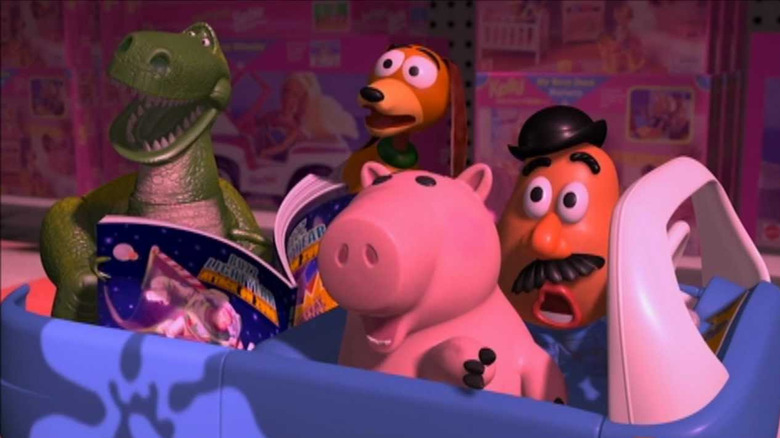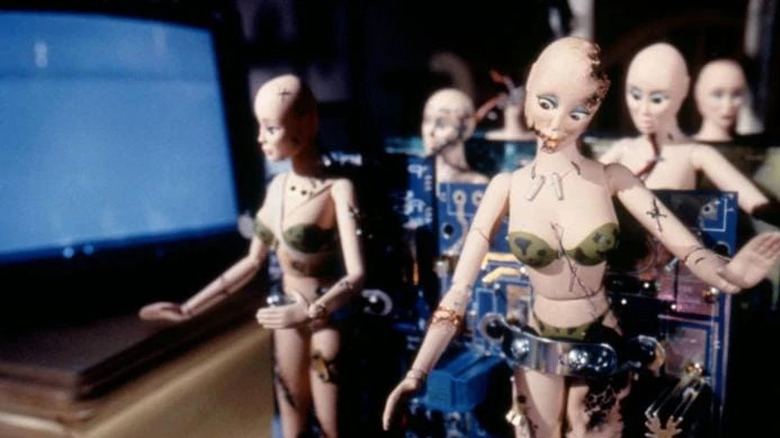Joss Whedon's Big Toy Story Idea Got Shut Down By Mattel
Much is made of Joss Whedon's work before his name became a loaded one in the pop culture sphere. But one part of his career gets little mention, despite its fascinating variety: Whedon was a script doctor, tweaking the likes of Kevin Reynolds' "Waterworld" (uncredited) and the mid-90s action banger "Speed." Between his "Buffy the Vampire Slayer" feature script and the later WB series of the same name, Whedon had a stint writing for Disney, earning a credit (alongside Andrew Stanton, Joel Cohen and Alec Sokolow) on a 1995 animated movie about little toys with big feelings.
John Lasseter brought Whedon on board to work on "Toy Story," a feature-length family movie with elements pulled from Pixar's early short film "Tin Toy." In "Joss Whedon: The Biography," Amy Pascale describes the initial draft of the script as a mess. "The leads, Woody the cowboy and Buzz Lightyear the astronaut, were sarcastic and unlikeable," Pascale says. "Not exactly ideal heroes for a children's movie." Whedon got to work whittling at the story's worst flaws and adding in the witty quips and details his characters are known for, like Rex the Dinosaur's neurotic concerns. The "Firefly" showrunner also tried to add another of his trademarks — feisty, strong women characters — through one of the most globally recognizable brands associated with female independence.
That's right, Whedon wanted Barbie to save the day.
We could've had a barb offensive
David A. Price's "History Of Pixar" dives into the long road "Toy Story" walks from concept to screen. In the book, Price recounts the four months Whedon spent on the project, which included "a pivotal role" for iconic fashion doll Barbie:
As Whedon pictured it, Woody and Buzz, seemingly doomed at Sid's house, would be rescued by Barbie in a commando style raid. Her character was to be patterned after Linda Hamilton's portrayal of Sarah Connor in Terminator 2. (The concept of a two-fisted, derriere-kicking heroine, still a novelty at the time, had also featured in Whedon's script for the 1992 film version of Buffy the Vampire Slayer.) Whedon's vision came to naught, however, when Mattel refused to license Barbie.
Sadly, Whedon's Barb brigade never made it to the big screen, thanks to Mattel's stinginess. Likewise, the reason why budding psychopath Sid blows up a Combat Carl with an M-80 is equally exhausting. In the DVD commentary for "Toy Story," Lasseter relates how G.I. Joe's explosive fate was too much for Hasbro, who refused to licensing rights to the doll. The toy and game conglomerate offered Mr. Potato Head instead, which Pixar clearly accepted. One could complain about a lack of badass dolls with knives, but Barbie did come along in 1999's "Toy Story 2" and for subsequent sequels, albeit without sports bras or incendiary devices.
For consolation (time for an aside!), director Joe Dante has what you need. Just three years after "Toy Story," but a year before Tour Guide Barbie graced the playrooms of "Toy Story 2," Dante's "Small Soldiers" took the what-if-your-toys-could-talk concept and oriented it towards a teen audience, and there are plenty of commando bargain bin Barbie parodies around — an overwhelming amount in fact, if the protagonists have anything to say about it. The Gwendy girls aren't your mama's dolls. In fact, when the dolls are reanimated by the villainous Commando Elite toys, a shrewd viewer might pick up the score from James Whale's classic sci-fi horror "The Bride of Frankenstein." The voice work for the Gwendy dolls is provided by Christina Ricci ("Yellowjackets") and Buffy herself, Sarah Michelle Gellar.
Joss Whedon's involvement with "Toy Story" ended long before the film's release in November 1995, but he is credited among the storytellers responsible for the second highest-grossing movie of the year (behind "Die Hard With A Vengeance") and a certifiable classic.

